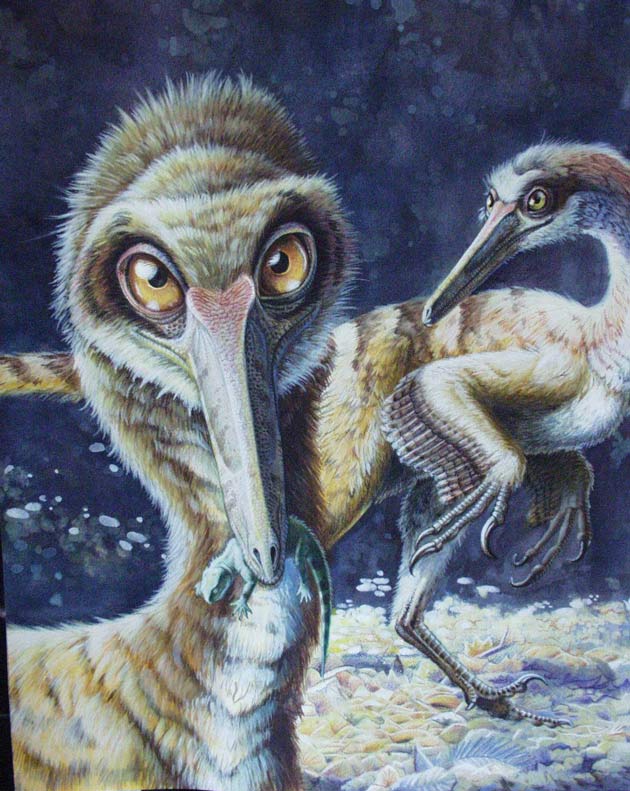Newfound Dinosaur Forces Rethink on Emergence of Raptors

The discovery of a bird-like dinosaur in South America has paleontologists rethinking when, where and how one group of raptors evolved.
The rooster-sized dinosaur is called Buitreraptor (bwee-tree-rap-tor) gonzalezorum. It has a long head and long tail and wing-like forelimbs. Its serrated teeth, like steak knives, suggest it was a carnivore.
Buitreraptor is related to Velociraptor, the presumed cunning killer made famous by Hollywood. Both belong to a class of birdlike dinosaurs that ran swiftly on two legs and are called dromaeosaurs.
The new find suggests such raptors go back much further in time that previously thought.
New timeline
Until recently, dromaeosaurs had been found only in Asia and North America and only in the Cretaceous period, which ran from 145 million to 65 million years ago. Evidence that they existed in the Southern Hemisphere has been mounting.
Today's announcement of a well preserved fossil represents the first definitive evidence that dromaeosaurs roamed South America. Here's why that's important:
Sign up for the Live Science daily newsletter now
Get the world’s most fascinating discoveries delivered straight to your inbox.
About 200 million years ago, Earth had just one giant land mass called Pangea. Toward the end of the Jurassic period, it split in two. Laurasia eventually became North America, Asia and Europe. The other chunk, Gondwana, developed into the continents of the Southern Hemisphere and India.
Since dromaeosaurs had only been found in places that used to be part of Laurasia, scientists figured the beasts evolved into being after Pangea split.
But the Buitreraptor fossil in South America, which dates back 90 million years and closely resembles fossils from the North, means one of two things:
Odds being against such striking parallel evolution, paleontologists speculate that dromaeosaurs likely originated more than 180 million years ago, before Pangaea broke apart. The newly discovered fossil also shows that the creatures developed slightly different characteristics after they split up.
"Buitreraptor is one of those special fossils that tells a bigger story about the Earth's history and the timing of evolutionary events," said Peter Makovicky, curator of dinosaurs at The Field Museum. "It not only provides definitive evidence for a more global distribution and a longer history for dromaeosaurs than was previously known, but also suggests that dromaeosaurs on northern and southern continents took different evolutionary routes after the landmasses they occupied drifted apart."
Odd duck
The Buitreraptor fossil was found in northwestern Patagonia about 700 miles southwest of Buenos Aires.
The field research was led by Argentine paleontologist Sebastián Apesteguía. The discovery is detailed in the Oct. 13 issue of the journal Nature.
Buitreraptor is an odd duck among dinosaurs. Its peculiarly long snout may have evolved to hunt snakes, mammals, and lizards that burrowed into the ground. Fossils of such critters found near Buitreraptor suggest that scenario.
The large, hollow wishbone of the dinosaur, along with its wing-like forelimbs and bird-like pelvis, add more evidence to the theory that birds evolved from dinosaurs, the scientists said.
An analysis of Buitreraptor also reveals it to be very similar to Rhonavis, which had been thought to be a primitive bird. The researchers now believe the two constitute a separate branch of the dromaeosaur family tree.
- Dinosaur Fossil Gallery
- Birds of Prey: Spot Today's Dinosaurs
- Avian Ancestors: Dinosaurs that Learned to Fly
- First Southern Hemisphere Raptor Dinosaur Found
- Ancient Flying Reptiles Discovered
Pangea
Pangea began to break up about 225-200 million years ago. This animation shows how it unfolded.

SOURCE: USGS
Robert is an independent health and science journalist and writer based in Phoenix, Arizona. He is a former editor-in-chief of Live Science with over 20 years of experience as a reporter and editor. He has worked on websites such as Space.com and Tom's Guide, and is a contributor on Medium, covering how we age and how to optimize the mind and body through time. He has a journalism degree from Humboldt State University in California.










